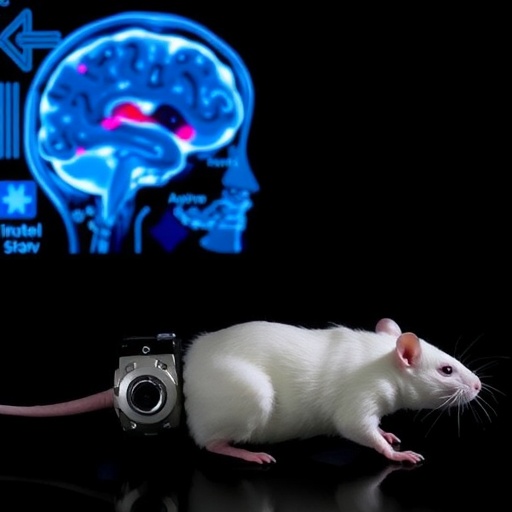Researchers have diverged into an innovative realm of rehabilitation by merging non-invasive brain stimulation techniques and robotic therapy to enhance motor recovery in a mouse stroke model. These groundbreaking methods challenge the limitations of traditional recuperative practices, which often fall short in fostering significant neurological improvements post-stroke. The development harnesses the power of cutting-edge neuromodulation alongside robotic-assisted rehabilitation strategies to engage and rehabilitate damaged motor pathways, unfolding a new lease of healing for neurological impairments.
Stroke not only affects motor functions but also disrupts complex neurophysiological interactions that govern fine motor control. This research investigates the impacts of gamma neuromodulation on parvalbumin interneurons—crucial components in the balanced regulation of cortical circuits that facilitate movement. These interneurons are often compromised during ischemic events, such as strokes, resulting in a cascade of motor deficits. The combination of targeted brain stimulation and robotic assistance acts synergistically to unlock the interneuron dynamics, promoting recovery in motor functions previously believed to be irretrievable.
The study meticulously outlines a well-designed experimental framework where mice were subjected to superficial ischemia, replicating stroke conditions. Within the recovery period, researchers observed these subjects receiving a regimented schedule allowing for both robotic-assisted movement therapies and gamma neuromodulation exposure. By sustaining this integrated approach over six weeks, they were able to chronicle significant shifts in the calcium signaling of parvalbumin interneurons, evidencing the biological changes instigated by the interventions.
In the context of neuroscience, the modulation of gamma frequencies opens a plethora of signals aimed at reinforcing synaptic efficiency and overall cortical excitability. Alpha and beta rhythms have been associated with cognitive loads, but gamma oscillations present a unique opportunity—imposing recovery-promoting vibrations that appear to enhance not just the reactivation of synapses, but also the excitatory-inhibitory balance vital for restoring motor commands. The intriguing aspect of this work lies in the fact that the benefits observed were not merely transient but persisted even in the weeks following active rehabilitation, suggesting a profound, possibly lasting, enhancement in neuroplasticity.
The robotic rehabilitation aspect is equally revolutionary. Unlike conventional physical therapy that often relies upon repetitive, manually-intensive exercises, robotic devices can deliver precise movement tasks in controlled yet varied environments, effectively adjusting to the recovery trajectory of each subject. This adaptation ensures a more personalized approach to rehabilitation—highlighting the robot’s ability to sense and respond to the participants’ real-time capabilities, thereby promoting a more engaging and efficient healthcare paradigm.
Furthermore, the multi-modal approach of this study raises some compelling questions regarding future applications. Could these methods translate successfully from murine models to human clinical trials? Already, the implications are profound for stroke patients who struggle to regain fundamental motor functions after rehabilitation attempts. The human brain, being remarkably adaptable, might witness a similar restoration of function, thus pushing the boundaries of neurorehabilitation further than ever speculated.
In blending these sophisticated therapies, the researchers fostered a platform for inquiry into the minutiae of cortical dynamics post-stroke, recognizing that more than mere physical recovery is at stake. Their twin focus on isolating neurobiological changes while facilitating physical movement draws attention to a broader concept: recovery must also encompass improvements in the cognitive frameworks that govern motor performance.
Furthermore, funding from various health and research projects underscores the urgency and importance of such studies amid a global health landscape marked by an increasing incidence of strokes. The support highlights an understanding among institutions that brain health remains paramount, requiring sustained investments into advanced methodologies that look towards integrative care solutions within neurological rehabilitation.
As research continues, it will be imperative to delve deeper into the mechanistic insights behind these findings. Understanding why certain internal conditions yield preferential neural adaptations will guide clinicians in tailoring effective treatments for diverse patient populations. Breaking free from the confines of convention, this exploration encourages a reexamination of typography in rehabilitation paradigms and reinforces the potential of integrative practices in enhancing recuperative outcomes.
Contributions from varying disciplines, including robotics, neurobiology, and physiotherapy, weave a complex tapestry of knowledge necessary for tackling the multifaceted problems associated with stroke recovery. The path to mainstream application hinges on collaborative efforts across fields, enabling researchers to design impactful interventions that resonate beyond academic circles into real-world clinical settings.
As we stand on the brink of potential breakthroughs in the realm of neurorehabilitation, this study beckons healthcare professionals to consider an expanded arsenal of rehabilitative techniques, fostering a dynamic landscape that embraces complexity and ingenuity. Now more than ever, a shift towards integrating technology with biology offers hope not only for improved recovery outcomes but an enriched quality of life for individuals grappling with the aftermath of stroke.
As research methodologies evolve and grow more sophisticated, embracing interdisciplinary approaches will be crucial in unlocking the mysteries of recovery mechanisms following brain injuries. This groundbreaking study exemplifies one such venture, spotlighting the transformative possibilities inherent within the nexus of neuroscience and advanced robotic technology, paving the way for an era where effective rehabilitation is widely accessible and undeniably impactful.
Subject of Research: Animals
Article Title: Combining gamma neuromodulation and robotic rehabilitation after a stroke restores parvalbumin interneuron dynamics and improves motor recovery in mice
News Publication Date: 2025
Web References:
References:
Image Credits: Credit: Vignozzi L, et al., 2025, PLOS Biology, CC-BY 4.0
Keywords
Stroke recovery, robotic rehabilitation, gamma neuromodulation, neuroplasticity, parvalbumin interneurons, advanced rehabilitation techniques, neuroscience, experimental study.
Tags: experimental stroke research in micegamma neuromodulation effectsintegrated rehabilitation strategiesischemic stroke recovery methodsmotor function restoration techniquesmotor recovery in stroke modelsneurological rehabilitation innovationsneurophysiological interactions post-strokenon-invasive brain stimulationparvalbumin interneurons functionrobotic rehabilitationrobotic-assisted therapy advancements





